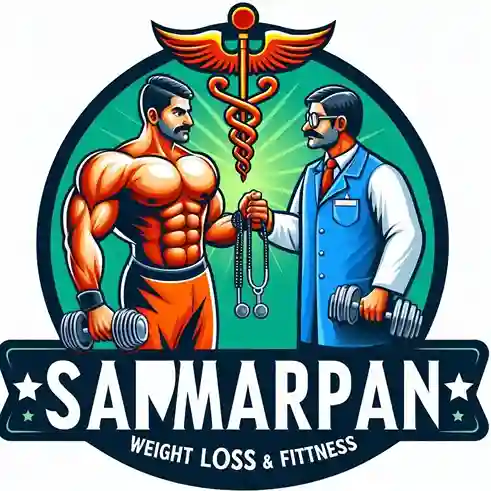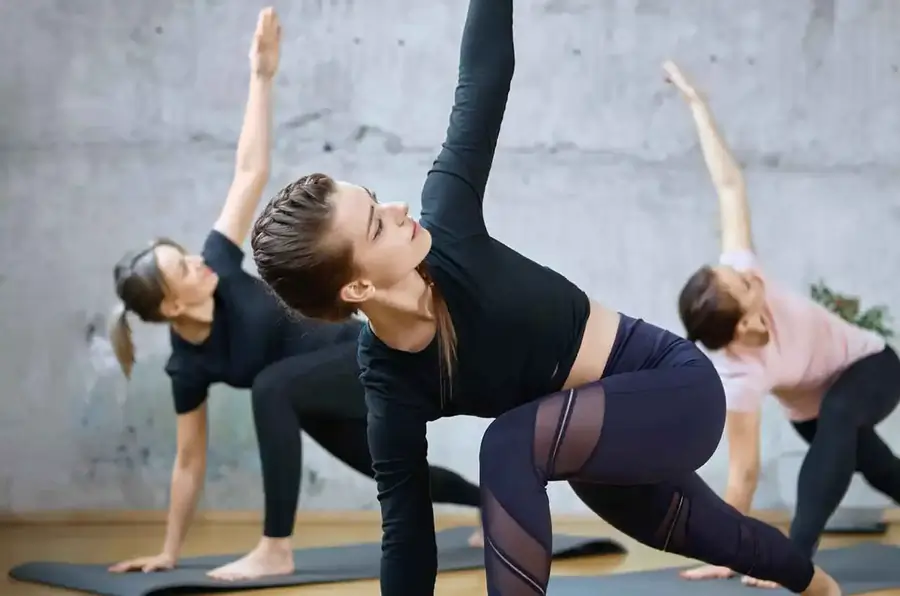Stretching And Flexibility Program
If you often neglect stretching exercises when you’re rushed for time, raise your hand. You’re not alone there, so don’t feel bad. However, there’s a strong reason to set aside a small amount of time.
A well-rounded fitness program should include mobility work, even though it may not be the most exciting aspect of exercise. By including stretching, you can increase flexibility, decrease tightness, and make your routines safer and more effective.
Tight muscles can harm nearby joints or put them under excessive strain while performing ordinary tasks. According to her, it’s critical to actively maintain and increase mobility as you age because your muscles become less elastic and shorter. This allows you to continue enjoying your daily activities pain-free.
What is Stretching?
To increase the perceived elasticity of a muscle and attain a comfortable muscle tone, stretching is a type of physical exercise that involves purposefully expanding and flexing a particular muscle or tendon (or muscle group). A sense of improved range of motion, flexibility, and muscle control is the end outcome. By expanding the range of motion, stretching is also used therapeutically to reduce cramps and enhance function in day-to-day tasks.
In its most basic form, stretching is an instinctual and natural movement that many animals, including humans, engage in. There may be yawning in conjunction with it. Stretching frequently happens naturally after waking up from slumber, after being inactive for extended periods, or after leaving cramped places. Stretching has also been observed in spiders and vertebrates, such as birds and mammals.
Stretching to increase flexibility is one of the core tenets of physical fitness. To lower their risk of injury and improve their performance, athletes frequently stretch both before (during warm-up) and after activity.
What Is Flexibility?
The range of mobility surrounding your joints is referred to as flexibility; it is comparable to the expansive and fluid movement of a well-lubricated door hinge. Think of the joints in your body as hinges on a door; the more easily and widely the hinge can swing open, the more flexible the door. Similarly, genuine flexibility is seen when your joints move painlessly and painlessly over their full range of motion.
It all comes down to how well muscles, tendons, ligaments, and joints work together to produce fluid, graceful, and unrestricted movements. Consider the graceful leg extension of a ballet dancer or the easy split of a gymnast. The body demonstrates an impressive range of mobility in both depth and breadth in these instances of flexibility in action.
However, flexibility is not limited to dancers or sports. It is essential to daily living. A certain amount of flexibility is necessary for many everyday tasks, such as reaching for a high shelf, bending to tie your shoes, or twisting to check behind you while driving.
What Are the Different Types of Stretching?
There are numerous varieties, and each has certain advantages. Typical forms of stretching include the following:
Passive Stretching: An external force (such as a towel, resistance band, gravity, or another person) aids in increasing the stretch during this kind of stretching. A hamstring stretch via a towel or belt is an additional example. It’s typically done for relaxation and after working out.
Static Stretching: In static stretching, a limb is extended to produce a stretch sensation, and it is then held there for some time, usually 20 to 45 seconds. Although “static stretching” and “passive stretching” are sometimes used synonymously, they have a slight distinction. Both passive and static stretching involve holding a stretch. However, static stretching differs from passive stretching in that you are supporting yourself while performing the stretch. Static stretches include, for instance, kneeling on the floor and maintaining a position to extend your hip flexor, which is the muscle in the front of your hip.
Active Stretching: Active stretching is the process of moving a limb into a muscle-stretching position and maintaining it there with your muscular strength. For instance, you can elevate one straight leg while lying on your back using your leg muscles until your hamstrings start to stretch. This method, which includes mild strength training, can be beneficial for those recuperating from injuries.
Isometric Stretching: This technique combines an active or static stretch with a static muscle contraction, meaning the muscle doesn’t alter length. The muscle you are stretching is being pushed against by some force. One example is a calf stretch, where you push into a wall in front of you with your arms, straighten your back leg with your heel pressing down, and then lunge one foot forward. Usually, you alternate between 30 seconds of muscle stretching and 10 seconds of muscle contraction. After that, do it three to six times. Because it gives the muscles additional signals from the neurological system telling them it’s OK to extend more, isometric stretching can be quite beneficial for persons who wish to increase their flexibility fairly quickly.
Proprioceptive Neuromuscular Facilitation (PNF): With the possible exception of a considerably shorter contract-relax scheme (15-second stretch and 7-second contraction), PNF is comparable to isometric stretching. This stretching technique likewise involves contracting the muscle opposing the one being stretched. This is how a hamstring stretch might appear. Have someone raise one leg toward the ceiling while you’re lying on your back until the rear of the raised leg stretches. For 15 to 30 seconds, hold there. After 7 to 15 seconds of hamstring contraction, perform 7 to 15 seconds of quadriceps (the muscle in the front of your leg) contraction. Let your hamstrings stretch a bit more while you relax. For 15 to 30 seconds, hold.
Dynamic Stretching: Moving your muscles through their complete range of motion with controlled activities helps you warm up for a workout and signals your brain to start moving. When you do dynamic stretching, you move to lengthen your muscles. Dynamic stretches include things like torso twists, leg swings, and walking lunges.
Somatic Stretching: Somatic stretching, in contrast to the other forms, does not call for holding a stretch for a predetermined amount of time. With a focus on paying attention to how the muscles feel, you use light, organic motions to relieve tense muscles. For instance, you may stretch and arch your back as you wake up, or you could let your head droop and observe the feelings that accompany it.
Static vs Dynamic Stretching
Static stretches, such as touching your toes, require you to hold the stretch for a while without moving. These stretches gradually lengthen your muscles.
Conversely, dynamic stretches are active motions that lengthen muscles without maintaining the stretch. Dynamic stretches increase mobility while warming up the body and joints by simulating real-life or athletic activities.
Another method is PNF (Proprioceptive Neuromuscular Facilitation) stretching, which targets muscles by tightening and relaxing them.
The Advantages of Stretching
Enhances your adaptability
Your general health depends on your flexibility, which can be improved with regular stretching. Enhancing your flexibility might help you avoid the decreased mobility that can accompany aging, in addition to making daily tasks easier.
Improves your range of motion
You have more mobility when you can move a joint over its whole range of motion. Consistently stretching can help you increase your range of motion. Although proprioceptive neuromuscular facilitation (PNF)-type stretching, which involves pushing a muscle to its limit, may be more beneficial for quick increases, both static and dynamic stretching are beneficial for expanding the range of motion.
Enhances your ability to conduct active activities
It has been demonstrated that dynamic stretches assist get your muscles ready for physical exercise. It might also help you perform better during an exercise or sporting event.
Improves the flow of blood to your muscles
Stretching daily could help your circulation. Increased blood flow to your muscles due to improved circulation will speed up your recuperation and lessen muscle discomfort, sometimes referred to as delayed onset muscle soreness or DOMS.
Enhances your posture
Poor posture might result from typical muscle imbalances. Musculoskeletal pain can be lessened and appropriate alignment can be promoted by combining the stretching and strengthening of particular muscle groups. Your posture may then improve as a result.
Assists in the prevention and treatment of back pain
Your range of motion can be reduced by tense muscles. You run a higher risk of putting tension on your back muscles when this occurs. By extending the muscles, stretching can aid in the recovery of an existing back issue.
By strengthening your back muscles and lowering your risk of muscle tension, a regular stretching regimen can also help avoid future back pain.
Is excellent for reducing stress
Your muscles are likely tense while you are under stress. This is because stress, both mental and physical, causes your muscles to tense up. Pay attention to the parts of your body like your neck, shoulders, and upper back where you often store your stress.
Can help you relax
Engaging in a consistent stretching regimen might help you become more flexible and mentally tranquil. Focus on mindfulness and meditation techniques to give your mind a mental vacation while you stretch.
Reduces tension headaches
Headaches brought on by tension and stress might disrupt your everyday routine. Stretching may help relieve headache tension in addition to a healthy diet, enough water, and enough sleep.
Which type of stretching is best for you?
The two primary forms of stretching that you have most likely heard of are dynamic and static, however, there are other varieties as well.
Moving your muscles and joints through their maximum range of motion (ROM), or as near to it as possible, is known as dynamic stretching. Static stretching involves holding a position for a while after sinking into it, ideally, until you begin to feel a slight pushback (but not to the point of strain or discomfort).
The type you select should ultimately depend on when you’re stretching, but both are necessary for a well-rounded workout regimen.
You’ll frequently see dynamic stretching built into a warm-up since it’s excellent for getting your muscles, tendons, and ligaments ready for exercise. Stretches like thread the needle, down dog to runner’s lunge, and cat-cow are a few examples of what to perform before working out. To prepare your body and brain for what is ahead, it is important to select dynamic stretches that replicate the movement patterns you will perform during your actual program.
While static stretching is best done as a final exercise, it may decrease strength, power, and explosiveness if done right before a workout. Static stretches, however, can help your body relax, your muscles relax, and your mind relax if you finish your exercise with them. They are crucial even when you aren’t exercising since they can help you become more flexible and less prone to muscle soreness and aches.
This article will concentrate on static stretching because mobility is crucial both inside and outside of the gym.
Why is stretching so important?
Stretching isn’t particularly glamorous, and it probably won’t provide you with the same energy boost as a run or an HIIT session. However, it’s essential for both your physical fitness improvement and your general well-being.
Stretching increases flexibility, or the lengthening of your muscles and tendons. Because of this, it is crucial for enhancing mobility, which is the capacity of a joint to move over its full range of motion (ROM). As previously reported by SELF, a wider range of motion may result in improved muscle recruitment during strength training. For instance, you can squat deeper if you have a greater range of motion in your hips and knees as well as flexibility in the surrounding muscles and tendons. In the end, having a broad range of motion and high flexibility can help you perform more workouts with the right technique and maximize their benefits.
Stretching has advantages outside of the gym as well. Regularly performing static stretches will help relieve any associated stiffness and achiness and counteract muscular shortening that occurs when you sit in one posture for extended periods. It can help release all the tight regions you feel, like the front of your hips when you get out of your chair after sitting for a long time or your hamstrings when you bend over to pick something up off the floor.
How to begin a stretching exercise program
Take your time if you’ve never done stretching before. Your body requires time to adjust to the stretches you’re doing, just like it does to other types of physical activity.
A firm understanding of appropriate form and technique is also necessary. If not, you run the danger of getting hurt.
You can stretch whenever you want. On the days you work out:
Before your activities, try to get in five to ten minutes of dynamic stretching.
After your workout, spend an additional five to ten minutes static or PNF stretching.
Schedule at least five to ten minutes for stretching on days when you aren’t working out. This can lessen discomfort and tightness in the muscles and increase flexibility.
When stretching, concentrate on the main muscle groups that aid in mobility, such as your quadriceps, hamstrings, calves, and hip flexors. Try exercises that stretch your neck, shoulders, and lower back to relieve tension in your upper body.
Avoid bouncing and hold each stretch for 30 seconds.
Stretching can be done every day once your muscles have warmed up, or after every workout or sporting event. To get you started, try this 5-minute stretching routine every day.
Top Stretching Activities to Increase Flexibility
Lunge with Spinal Twist
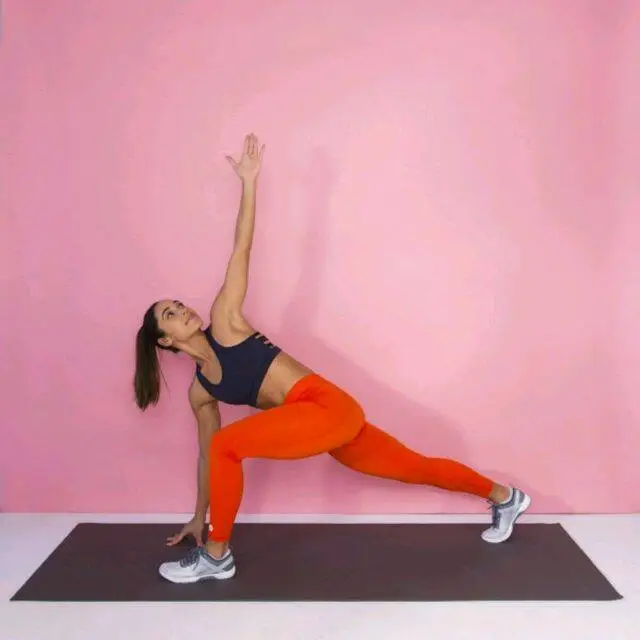
- Place your feet together to begin.
- To get into a staggered stance, take a large step forward with your left foot.
- To feel a stretch in the front of your right thigh, bend your left knee and drop into a lunge while maintaining your right leg straight behind you and your toes on the floor.
- Stretch your left arm toward the ceiling while keeping your right hand on the floor and twisting your upper body to the left.
- Hold for a minimum of thirty seconds.
- Continue on the opposite side.
Forward Fold
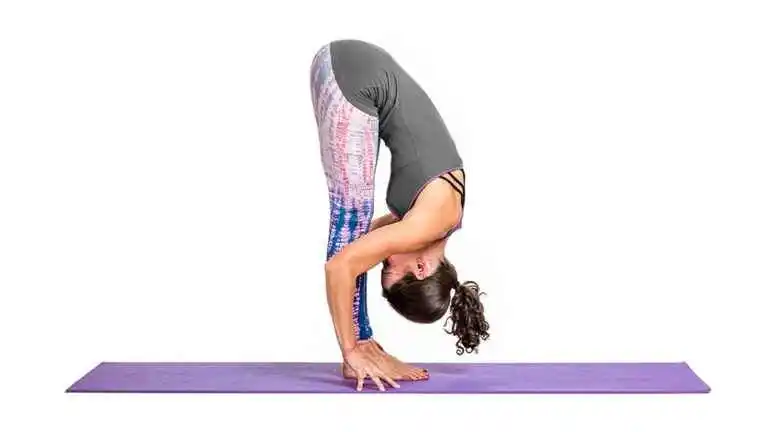
- Place your arms by your sides, knees slightly bent, and feet hip-width apart.
- Exhale as you raise your head toward the floor and fold forward from the hips. To generate a long spine, tuck your chin under, ease your shoulders, and consider extending the top of your head toward the floor.
- To prevent your knees from locking out, keep them straight but bend them slightly. Your back will be better protected this way.
- Touch the floor with your fingertips. You can also place your arms over your legs if that is more comfortable for you.
- For at least 30 seconds, hold. Do not forget to breathe.
- Bend your knees and roll up steadily, starting with the lower back and stacking one vertebra at a time.
Piriformis Stretch
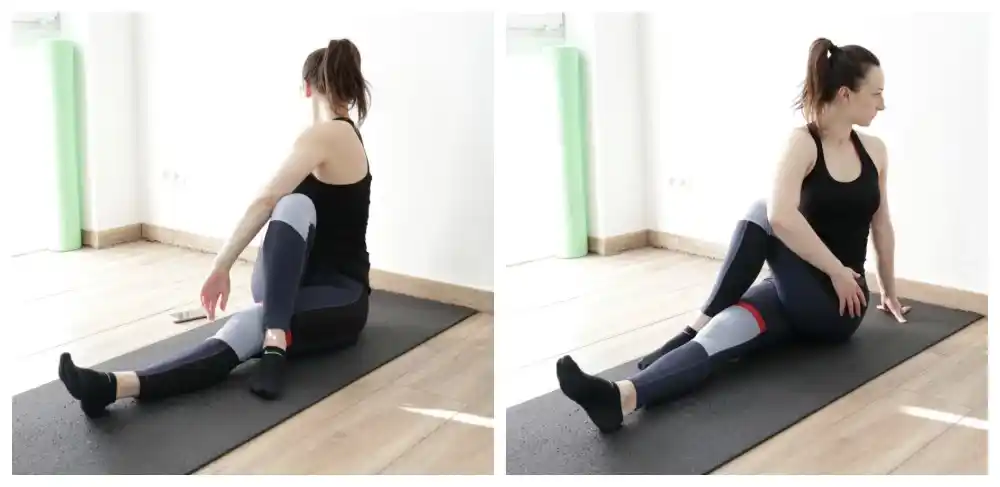
- With both legs out in front of you, take a seat on the floor.
- Place your right foot flat on the floor and cross your right leg over your left.
- Put your right hand behind your body on the floor.
- As you rotate your body to the right, press your right leg to the left while placing your left hand on your right quad or your left elbow on your right knee, as indicated.
- Hold for a minimum of thirty seconds.
- Simply pull your right quad in and to the left with your left hand if the spinal rotation causes pain in your back.
Toes on Wall Calf Stretch
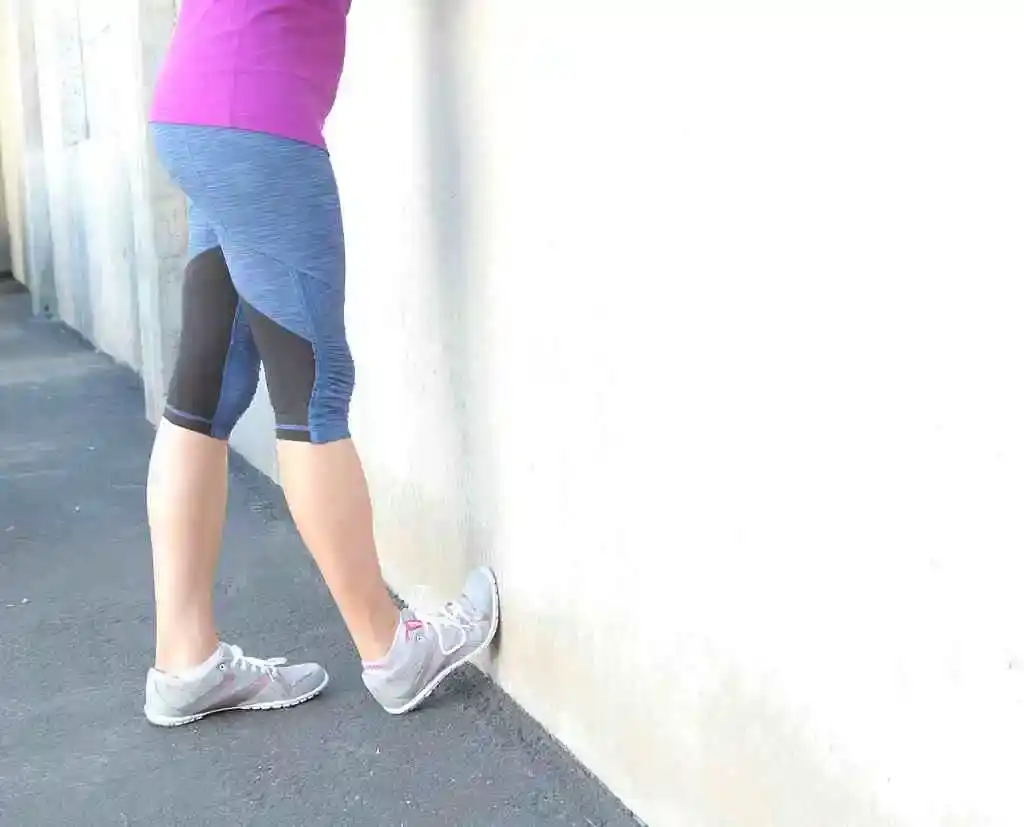
Position yourself so that one foot is close to the wall and one foot is about a foot back, with a wall in front of you. For support, place your palms on the wall.
Place your toes against the wall and your heel on the floor by bringing your front foot near the wall. To feel the stretch along the bottom portion of your front leg, shift your weight into your front foot. (You can elevate yourself on the toes of your back foot and bring your torso closer to the wall to make the stretch more intense.)
After at least 30 seconds of holding, switch sides and do it again.
Triceps Stretch
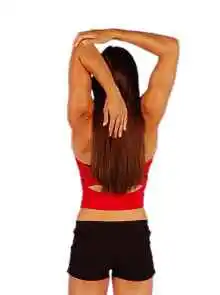
With your arms outstretched high and your feet hip-width apart, kneel, sit, or stand tall.
Reach your right hand to the upper middle of your back while bending your right elbow.
Grab your left hand immediately below your right elbow by reaching it overhead.
Your right elbow should be gently pulled down and toward your head.
Hold for a minimum of thirty seconds.
Repeat after switching arms.
Standing Quad Stretch
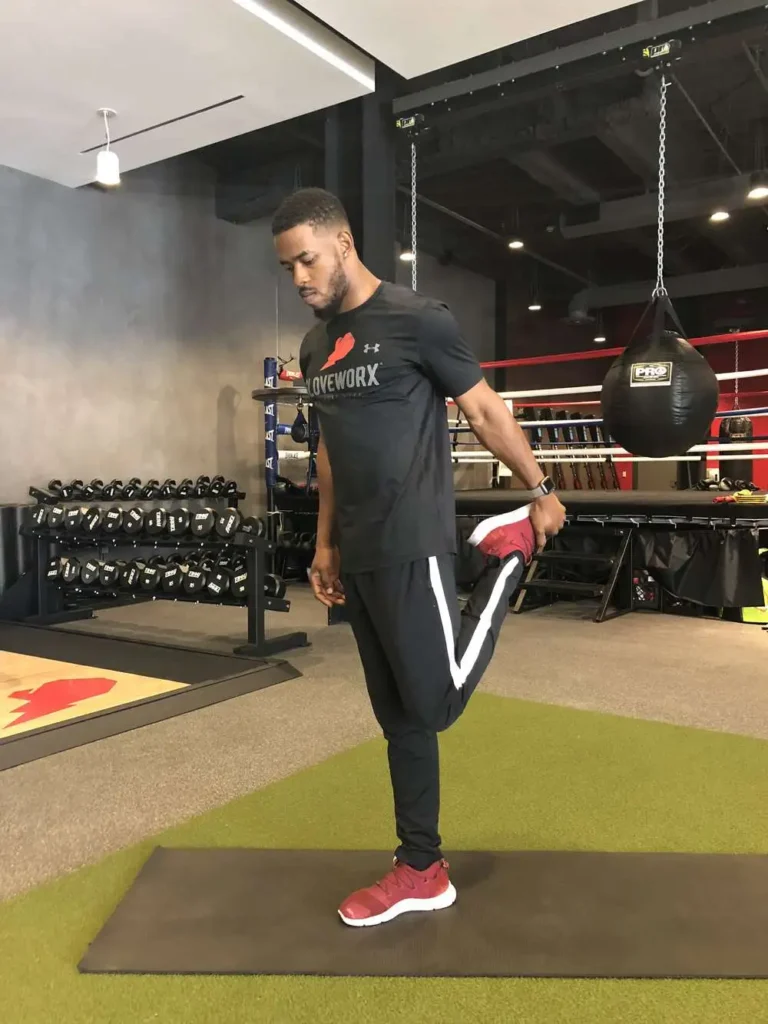
Place your feet together as you stand.
Pull your left foot toward your butt with your left hand while bending your left knee. Keep your knees together.
For balance, place one hand on a wall if necessary.
To increase the stretch in the front of your legs, squeeze your glutes.
Hold for a minimum of thirty seconds.
Do the same with the other leg.
Figure Four Stretch
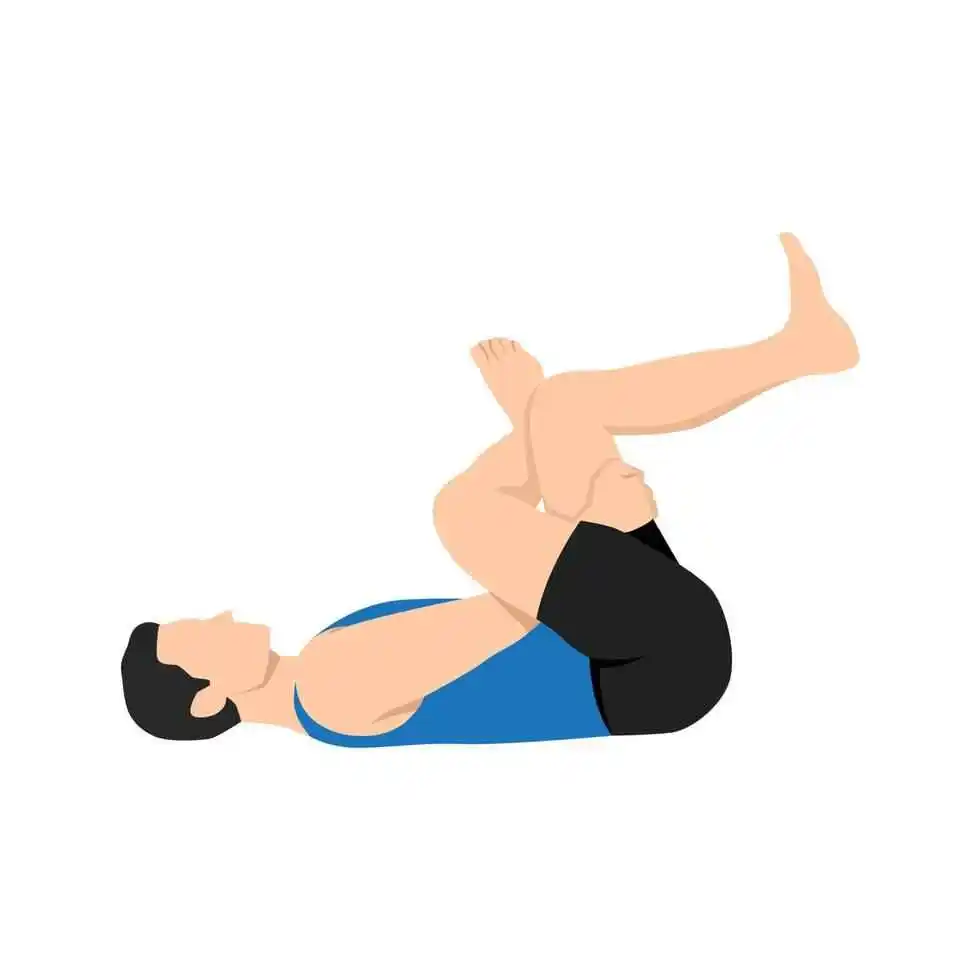
Place your feet flat on the floor and lie on your back.
Over your right quad, cross your left foot.
Raise the right leg off the ground. Take hold of your right leg’s back and gradually draw it up to your chest.
Hold there until the stretch feels comfortable.
Hold for a minimum of thirty seconds.
Repeat after switching sides.
Hip Adductors Stretch
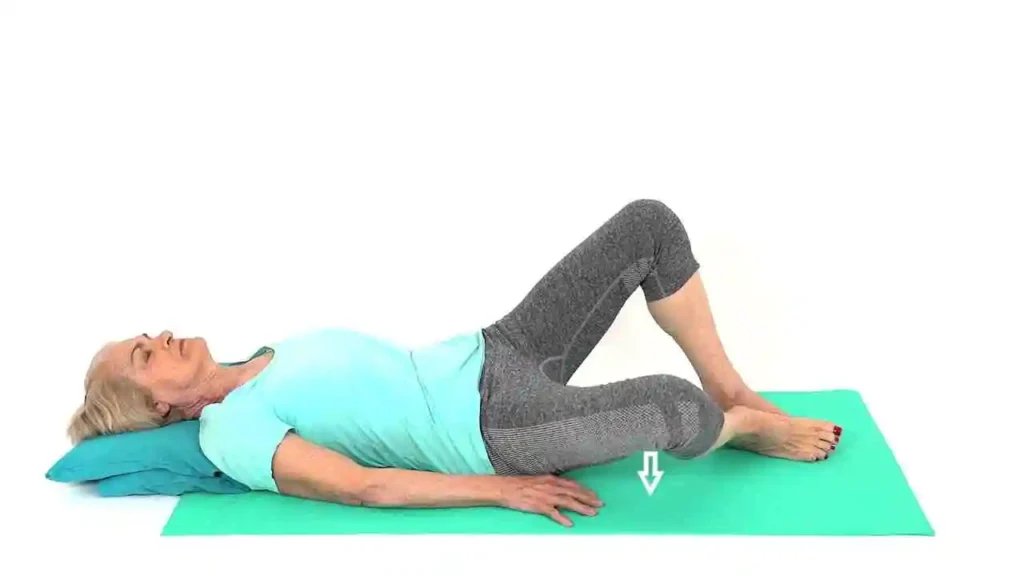
Place your feet slightly wider than shoulder-width apart and stand tall.
Bend your right knee a little as you shift your weight to the right. While maintaining your left hip pushed down, slightly raise your right hip. The inside of your left leg ought to feel stretched.
After at least 30 seconds of holding, switch sides and do it again.
Lying Pectoral Stretch
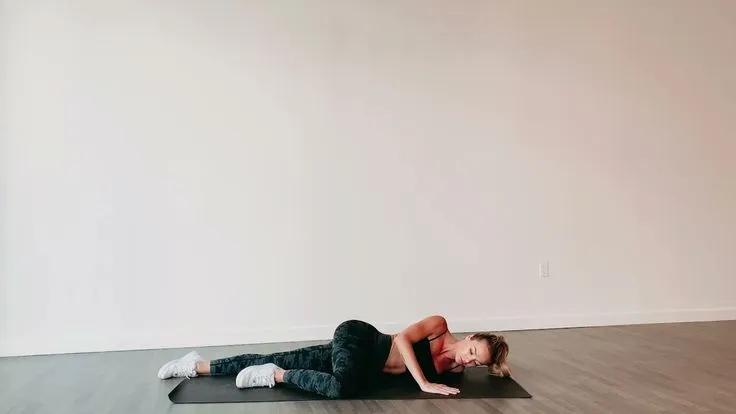
Position your body in a T form by lying on your stomach with both arms out to the sides.
As you begin rolling to your right side, use your left hand to push off the ground and bend your left knee for balance. This should be felt in the pectoral muscles on your right side.
Hold for a minimum of thirty seconds.
Continue on the opposite side.
90/90 Stretch
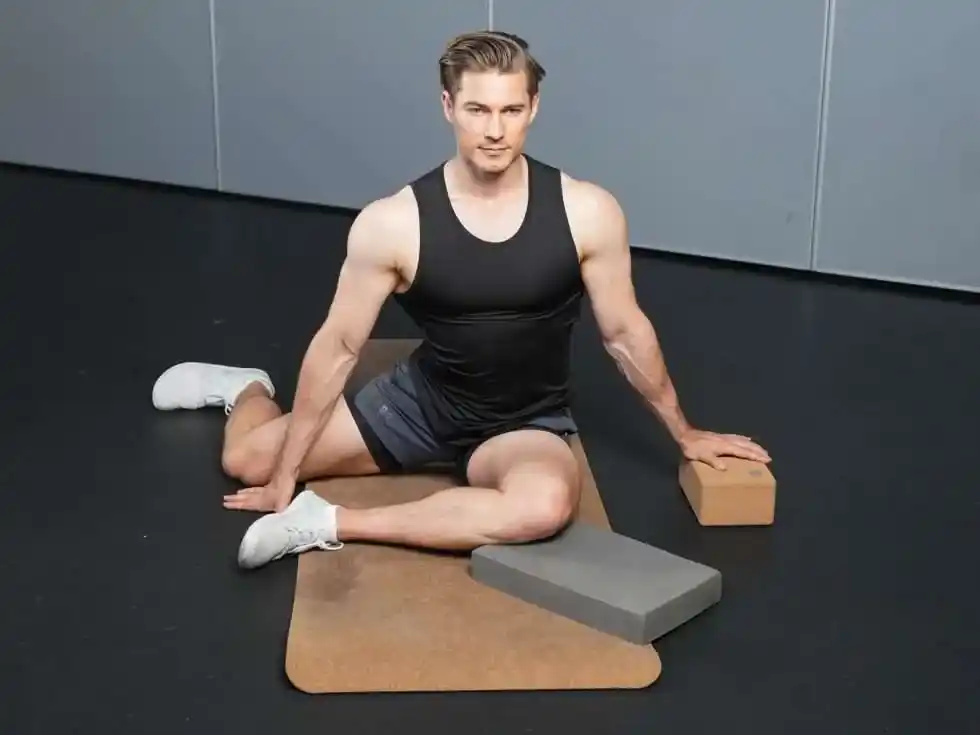
With the sole of your foot facing left and your right knee bent at a 90-degree angle in front of you, your calf should be perpendicular to your torso. Maintain a flexed right foot.
Place your leg flat on the ground.
Bend your left knee so that your foot is facing behind you and place it to the left of your body. Maintain a flexed left foot.
Your right butt cheek should remain on the ground. Make an effort to bring the left cheek as near to the ground as you can. If you’re extremely tight, it might not be feasible.
Hold for a minimum of thirty seconds.
Continue on the opposite side.
Seated Shoulder Squeeze
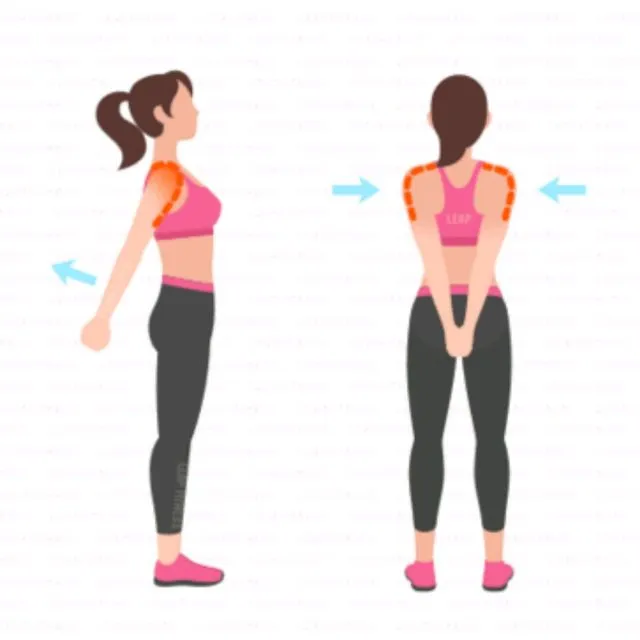
With your feet flat on the ground and your knees bent, take a seat on the floor.
Put your hands behind your lower back and clasp them.
Stretch your arms out and straighten them, then squeeze your shoulder blades together.
After three seconds of doing this, let go. Five to ten times, repeat.
Lunging Hip Flexor Stretch
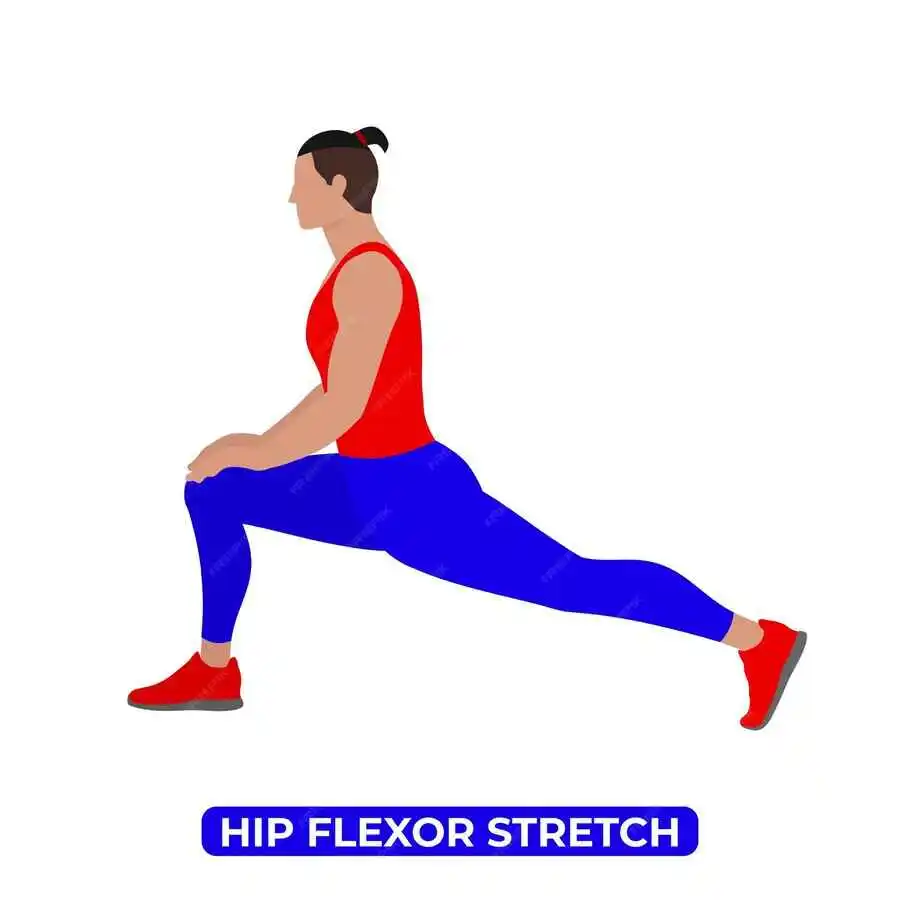
On your right knee, bend. With your knee bent, place your left foot flat on the floor in front of you.
Stretch your right hip toward the floor as you lean forward.
You can further stretch your hip flexor by squeezing your butt.
Hold for a minimum of thirty seconds.
Repeat after switching sides.
Kneeling Side Bend Stretch
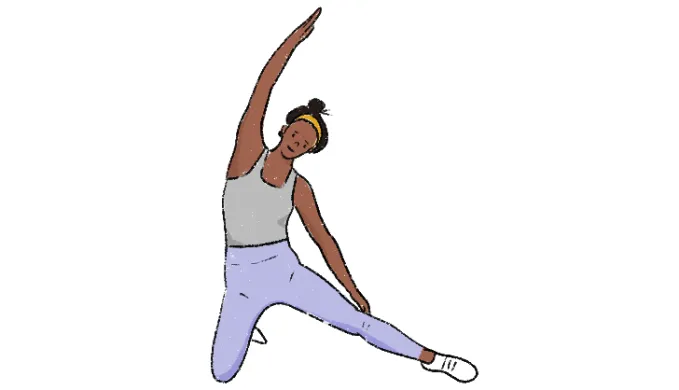
With your back straight, your knees together, and your core tense, kneel on the floor.
Stretch out your left leg to the side. Don’t place it in front of or behind you; instead, keep it perpendicular to your body.
Gently bend your torso and right arm to the left side after extending your right arm overhead and resting it on your left leg.
Maintain a forward-facing hip position.
Take minimum 30 seconds to hold this position.
Continue on the opposite side.
Frog Stretch
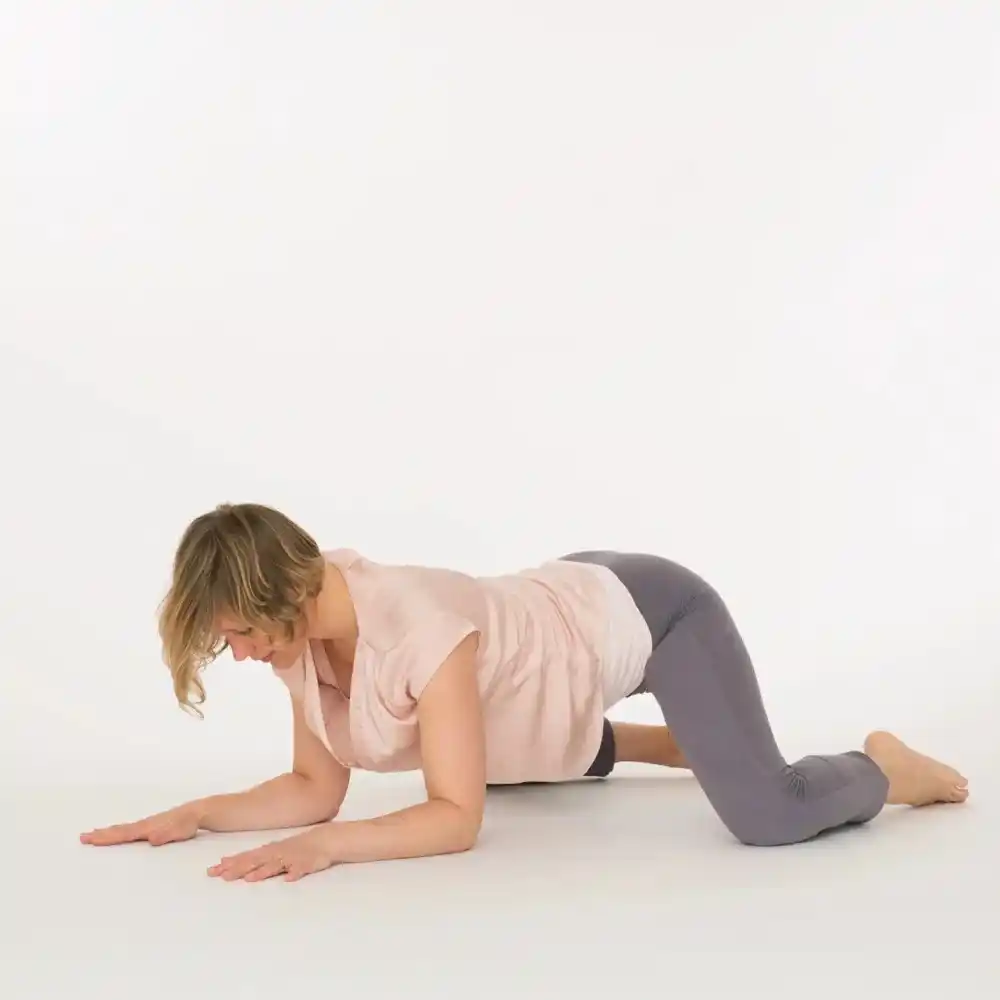
Get down on your hands and knees.
Adjust your knees so that they are more than shoulder-width apart.
Place the inside sides of your feet flat on the floor and turn your toes out.
Reposition your hips to your heels.
For a deeper stretch, try moving from your hands to your forearms.
Hold for a minimum of thirty seconds.
Sphinx Pose
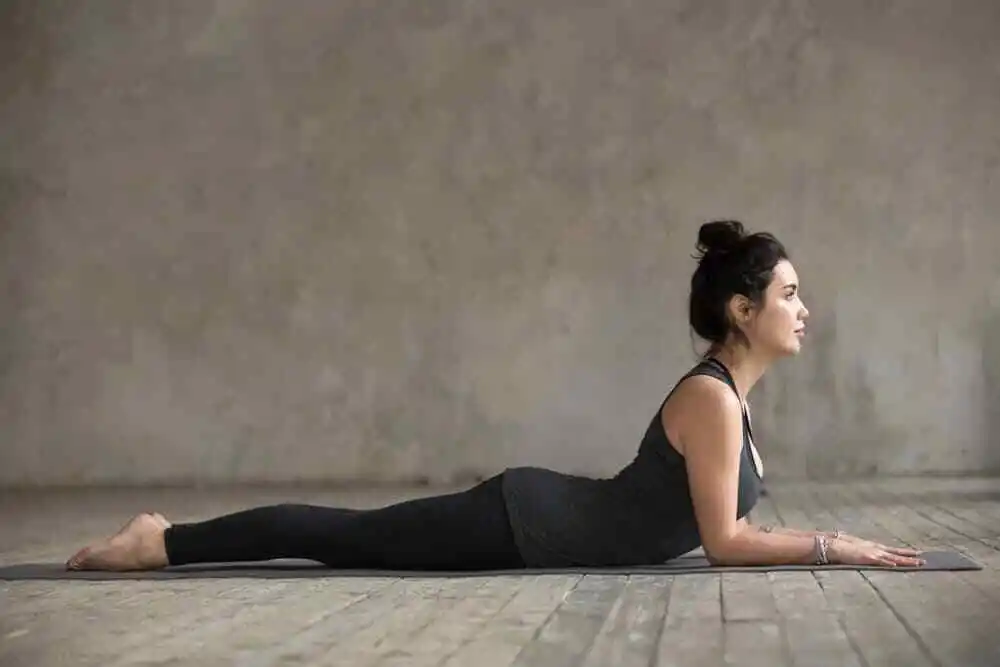
After lying on your stomach, extend your legs outwards behind you.
As you raise your torso off the ground, place your forearms on the floor and your elbows beneath your shoulders.
While keeping your shoulders relaxed, try to stretch your spine by pressing your hips and thighs into the floor.
Just enough sitting up will give your lower back a pleasant stretch. Avoid overextending your back, and if you experience any pain or discomfort, stop right once.
Hold for a minimum of thirty seconds.
Knee to Chest Stretch
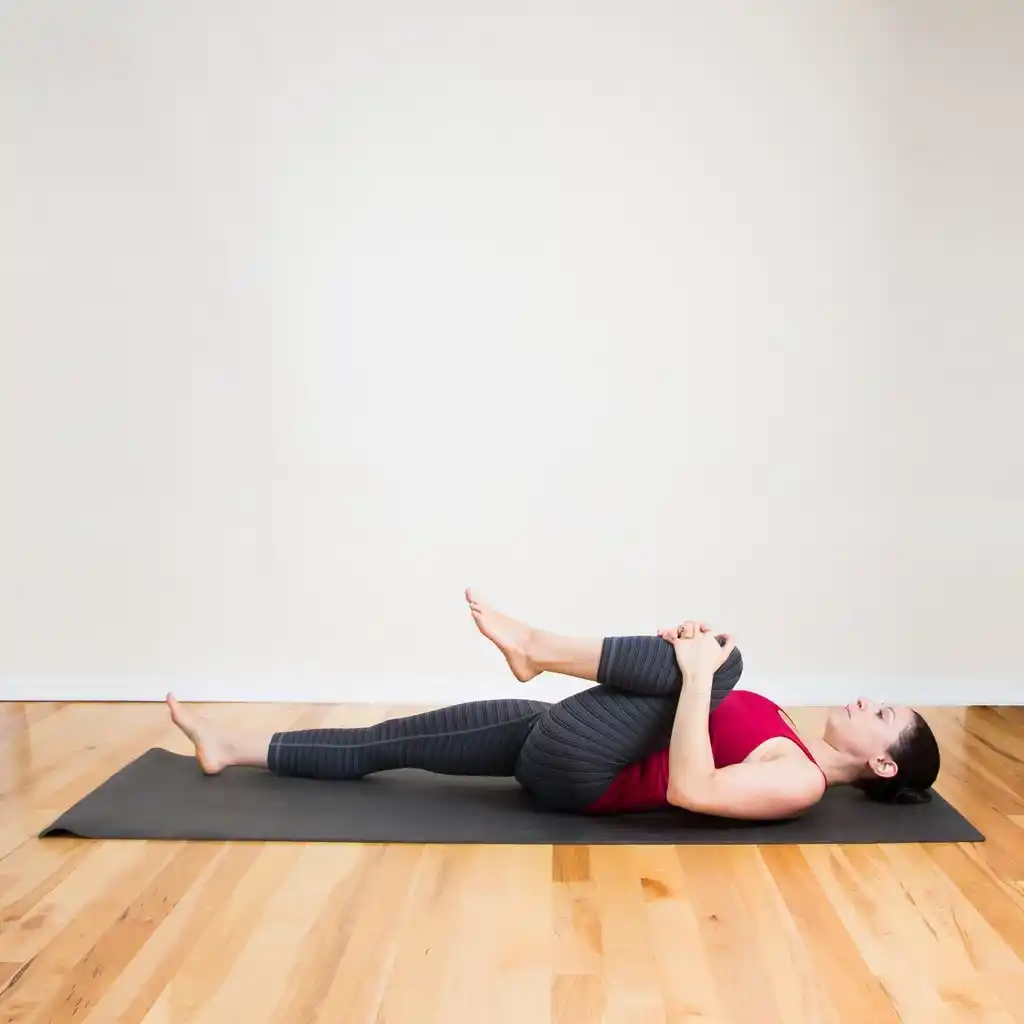
Stretch both legs out while lying on your back.
With your lower back pressed against the floor and your left leg straight, bring your right knee into your chest.
Take minimum 30 seconds to hold this position.
Do the same with the other leg.
Reclined Spinal Twist
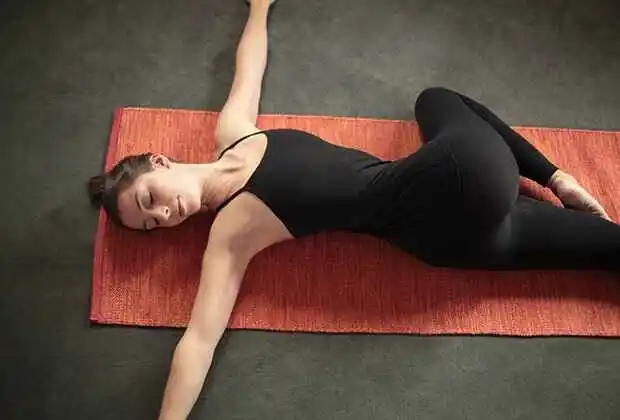
Rest on your back.
Embrace your knees with your neck. Next, twist your torso in the opposite direction while lowering both knees to one side.
As you draw your knees and hips toward the floor, try to keep them in alignment with one another. Aim to keep your chest as square to the ceiling as possible.
Repeat on the opposite side after holding this stretch for 30 to 60 seconds.
Seated Neck Release
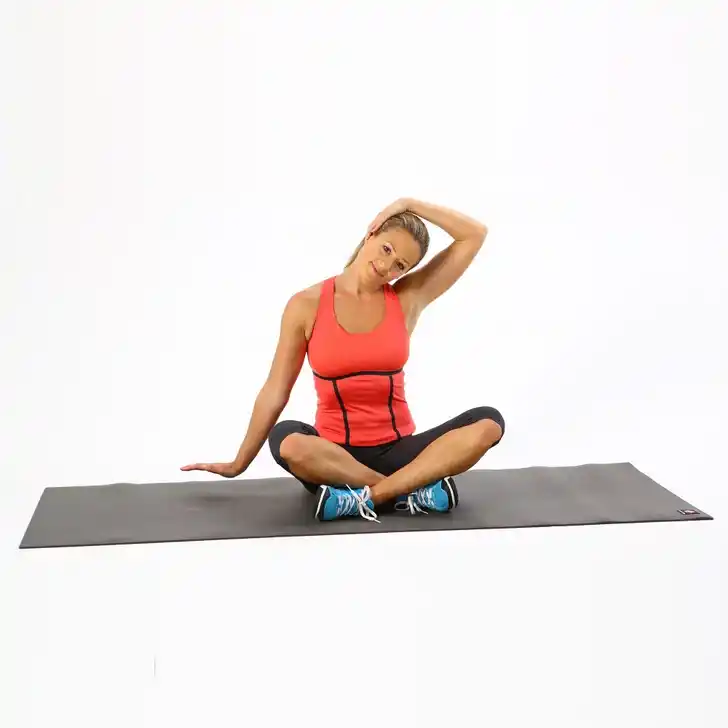
Either sit with your back straight and your chest raised, or stand with your feet shoulder-width apart.
To your left shoulder, drop your left ear.
Use your left hand to gently press down on your head to increase the stretch.
Hold for a minimum of thirty seconds.
Continue on the opposite side.
Hazards and precautions
It’s not always safe to stretch:
- You should only execute the stretches that your doctor has prescribed if you have an acute or chronic injury.
- To create a stretching regimen that works for you, consult a sports medicine specialist or physical therapist if you have a persistent or bothersome injury.
- See your physician for other stretching exercises that can help you improve your flexibility if you have any physical restrictions that make it difficult for you to do them correctly.
There are certain common stretching safety guidelines that you should adhere to regardless of your level of fitness:
- Avoid bouncing: Ballistic stretching was once believed to be the most effective method for improving flexibility. Experts now advise against bouncing unless a physician or physical therapist has prescribed these kinds of stretches for you.
- Don’t push yourself past your comfort zone: You should never experience pain when extending a muscle, even though some tension is typical. Back off the stretch until you are comfortable if the region you are stretching becomes uncomfortable.
- Don’t go overboard: Stretching strains your body, just as other types of exercise. You run the danger of overstretching and injuring your muscles if you stretch the same ones repeatedly throughout the day.
- Make sure you are prepared for your stretches: Stretching is much more challenging when muscles are cold because they are less flexible. Stretching is best done after working out, but if you’re not working out before stretching, try warming up with some light aerobic activity, like jogging or walking, for five to ten minutes.
FAQs
A full-body stretching program: what is it?
By including a full-body stretching regimen into your daily routine, you may increase your athletic performance and training exercise output while also strengthening your biomechanics and lowering your chance of injury. The best full-body stretching regimen is described in this article.
Why is a full-body stretching regimen necessary?
Your age, amount of expertise, or training discipline as an athlete are irrelevant. By including a full-body stretching regimen into your daily routine, you may increase your athletic performance and training exercise output while also strengthening your biomechanics and lowering your chance of injury.
Which stretches are best for the lower body?
One of the most common lower-body stretches is the quad stretch, particularly after a cardiac exercise like cycling or running. Unlike the usual standing version, the lying-down form eliminates the need for balance, allowing you to concentrate entirely on blending into the dance.
What advantages do flexibility and stretching exercises offer?
Exercises for flexibility and stretching maintain healthy muscular function and increase range of motion. Additionally, there are other potential advantages to training your body to be more flexible, such as a lower chance of injury, greater strength, better posture, and enhanced balance.
How is the degree of flexibility measured?
Flexibility tests that gauge a joint’s range of motion are typically used to evaluate flexibility. The Sit-and-Reach Test, which evaluates the hamstring and lower back muscles’ flexibility, is one popular technique.
Is stretching a way to relax?
Another way to relax is by stretching. It relieves tense muscles, which can lessen stress and enhance well-being. Stretching aims to increase muscle length and improve flexibility, in contrast to other types of exercise that concentrate on developing strength or endurance.
In sports medicine, what does stretching mean?
Sports medicine Stretching is a therapeutic technique used to lengthen shortened soft tissue structures and increase flexibility. It should ideally come before exercise and is meant to maintain muscle suppleness and enhance joint range of motion.
Reference
- Cpt, P. W. (2024, May 2). 8 Total body stretching exercises to improve flexibility. Verywell Fit. https://www.verywellfit.com/relaxing-total-body-stretches-1231150
- Lindberg, S. (2023, May 19). Stretching: 9 benefits, plus safety tips and how to start. Healthline. https://www.healthline.com/health/benefits-of-stretching#safety-tips
- CPT, A. M. W., & CPT, C. S. (2023, November 10). The 24 best stretching exercises for better Flexibility. SELF. https://www.self.com/gallery/essential-stretches-slideshow
- Advanta Health Solutions. (2024, May 7). Flexibility vs. Stretching: What’s the Difference? ActiveFit+. https://www.activefitblog.com/post/flexibility-vs-stretching-what-s-the-difference
- Athlete, M. (2021, December 31). The Ultimate Full-Body Stretching Routine. Mobility Athlete. https://mobilityathlete.com/full-body-stretching-routine/
